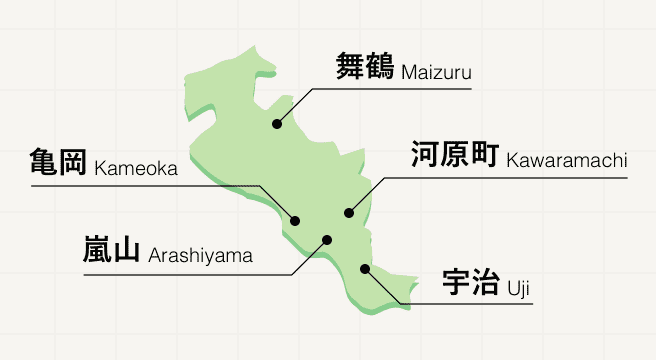Other Sightseeing Spots in Around Kiyomizu-Dera Temple Area
Area
-
-
Kyoto
-
-
Kyoto
-
-
Around Kiyomizu-Dera Temple
-
- All areas
- Around Gion
- Around Kiyomizu-Dera Temple
- Around Okazaki
- Around Ginkaku-Ji Temple
- Ichijo-ji Temple / Shugakuin
- Around Fushimi Inari
- Around Kyoto Station
- City Center
- Around Kyoto Imperial Palace
- Around Nishijin
- Around Kamigamo
- Around Kinkaku-Ji Temple
- Uzumasa / Hanazono
- Arashiyama / Sagano / Takao
- Around Mt. Hiei
- Ohara / Kurama / Kifune
- Katsura / Nishiyama
- Yamashina / Daigo
- Around Fushimi
- Around Uji
- Joyo / Yawata
- Kyotanabe / Kizugawa
- Kameoka / Nantan
- Maizuru / Miyazu
-
Around Kiyomizu-Dera Temple

Category


-
- Ninenzaka
- Travel / Tourism
- Kyoto Kyoutoshi Higashiyama-ku Kiyomizu 2-chome
- This is a slope leading to Kiyomizu-dera Temple, its loose paving stones and lines of houses giving off a Kyoto atmosphere. It is a popular shopping spot with a number of Kyoto souvenir stores with goods including traditional confectionery, Japanese-style sundries and chirimen-sansho (dried baby sardines with Chinese pepper). It is recommended to stop for a break along the way at a cafe featuring Japanese-style sweets.
-
- Sannenzaka (Sanneizaka)
- Travel / Tourism
- Kyoto Kyoutoshi Higashiyama-ku Kiyomizu 2
- One of Higashiyama’s most famous tourist spots, this steep stone paved 100 meter hill road leads from Yasaka to the Kiyomizu-dera Temple. When the Kiyomizu-dera Temple was founded in 808, this path was built for visitors. The path is lined with souvenir shops, ceramic stores, and Japanese restaurants, giving it a truly Kyoto air. The hill is also called Sanneizaka. There are many theories as to its derivation, but based on the characters which comprise it (meaning “to give birth” and “preference,” it is widely believed that it gained this name from the parishioners climbing it to reach the Koyasu-no-to and pray for a safe childbirth.
-
- Gojo-zaka
- Travel / Tourism
- Kyoto Kyoutoshi Higashiyama-ku Kiyomizu · Gojo Bridge east
- Gojo-zaka is renowned as the birthplace of Kiyomizu-yaki pottery, one of Kyoto's hallmark traditional industries, in league with Nishijin Textile and the Kyo-yuzen dyeing technique. Gojo-zaka refers to the area from Yamato-oji Street to Kiyomizu-zaka Slope. In summer the Kyoto Gojo-zaka Pottery Festival is a sign of the season. Featuring over 400 pottery dealers, it's always bustling with visitors during that period.
-
- Kiyomizuzaka
- Travel / Tourism
- Kyoto Kyoutoshi Higashiyama-ku Kiyomizu
- This is a one kilometer road leading up to Kiyozumi-dera Temple. From the point where it merges with Gojozaka, one can begin to see the bustle of people along with rows of souvenir shops and restaurants. It is also a street where one can see many visitors wearing kimonos and visitors coming from abroad.
-
- Kiyomizu Shinmichi (Chawanzaka)
- Travel / Tourism
- Kyoto Kyoto-shi Higashiyama-ku Kiyomizu Gojohashihigashi
-
- Toufukujiengetukyou
- Travel / Tourism
- Kyoto Kyoutoshi Higashiyama-ku Honmachi 15-778 Tofukuji within
Kyoto Areas

Its wooden tea houses, shuffling geisha, and spiritual sights have seen Kyoto hailed as the heart of traditional Japan, a world apart from ultramodern Tokyo. Despite being the Japanese capital for over a century, Kyoto escaped destruction during World War II, leaving behind a fascinating history which can be felt at every turn, from the fully gold-plated Kinkakuji Temple down to traditional customs such as geisha performances and tea ceremonies, which are still practiced to this day.
Best of Kyoto
Search by Region
-
- Hokkaido / Tohoku
- Hokkaido
- Aomori
- Iwate
- Miyagi
- Akita
- Yamagata
- Fukushima
-
- Kanto
- Ibaraki
- Tochigi
- Gunma
- Saitama
- Chiba
- Tokyo
- Kanagawa
-
- Koshinetsu / Hokuriku
- Niigata
- Toyama
- Ishikawa
- Fukui
- Yamanashi
- Nagano
-
- Tokai
- Gifu
- Shizuoka
- Aichi
- Mie
-
- Kinki
- Shiga
- Kyoto
- Osaka
- Hyogo
- Nara
- Wakayama
-
- Chugoku
- Tottori
- Shimane
- Okayama
- Hiroshima
- Yamaguchi
-
- Shikoku
- Tokushima
- Kagawa
- Ehime
- Kochi
-
- Kyushu / Okinawa
- Fukuoka
- Saga
- Nagasaki
- Kumamoto
- Oita
- Miyazaki
- Kagoshima
- Okinawa
















